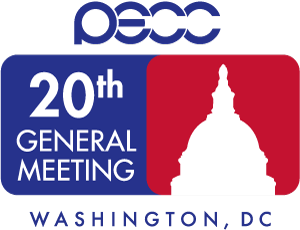PECC XX: Twentieth PECC General Meeting
From September 28, 2011 until September 30, 2011
At USA, Washington DC.
Categories: PECC Events
Hits: 3467

State of the Region
September 28-30, 2011
The Madison Hotel, Washington D.C., USA
(Program as at 14 Sep 2011)
|
Wednesday, September 28 |
|
|
Opening Dinner Speaker: Deputy US Trade Representative Demetrios Marantis (video) |
|
|
Thursday, September 29 |
|
|
0800 |
Registration and Coffee |
|
0830 |
Introductions and Opening Remarks |
|
0845 |
Asia Pacific Regional Outlook Overview and Forecast
Question and Answers (video) |
|
1000 |
Opening Address
|
|
1030 |
Concurrent Sessions:
Overview: Services are a key driver of regional economic growth and competitiveness. The services industry adds value of more than 50 percent to regional GDP. All APEC economies are successfully exporting services of one kind or another. Governments often claim, nevertheless, to have touble understanding where their commercial interests in services lie. The data paucity and resulting relative ignorance of the services economy leads to policy defensiveness and widespread reluctance to open up to foreign participation. Meanwhile, new evidence is emerging that shows that the regional services economy suffers from relatively high levels of government intervention, which has had a negative impact on competitiveness. The average services share of total exports for the APEC region is well below the global average. The determinants of services competitiveness and export performance are relatively poorly understood. Nor has the role of services in global and regional value chains been adequately studied or understood. The benefits of regulatory reform for services have not been widely advocated. And far too little attention has been given to improving the governance arrangements for 21st century trade and investment in services. The inter-governmental agenda lags badly behind the fast-changing business realities in the market place. The task of rebalancing global growth in the aftermath of the recent global financial crisis could be helped by designing more effective strategies for services, both domestically and internationally. This Concurrent Session will examine these issues. Concurrent Session Facilitator:
Speakers:
Rapporteur:
Overview: The Trans-Pacific Partnership (TPP) is a multilateral free trade agreement that would further liberalize trade among a group of Asia-Pacific economies. The original parties to the agreement, Brunei, Chile, New Zealand and Singapore are negotiating with five additional economies - Australia, Malaysia, Peru, United States, and Vietnam - that wish to join the group. TPP is considered by APEC to be a pathfinder for its proposed Free Trade Area of the Asia Pacific (FTAAP). While TPP would result in trade benefits to its members, its implications for non-members,whom it may disadvantage, are raising new questions and concerns in the region. These include, for example, the potentially widespread application of newly proposed intellectual property protections for TPP members as well as trade discrimination in sensitive sectors such as agriculture and other areas. At the same time, the economic advantages for non members arising from possible accession to the TPP have stirred strong domestic policy debates in several regional economies. This session will reflect perspectives from both the "inside," i.e., the parties to the negotiations, and the "outside," the non-participants, with a view to developing a more complex and, it is hoped, nuanced understanding if the implications of the TPP for the Asia Pacific region. Concurrent Session Chair:
Speakers:
Paths to More Inclusive Growth Overview: At APEC 2010 Yokohama, the leaders agreed to pursue five growth strategies: balanced, inclusive, sustainable, innovative, and secure growth. Under the banner of inclusive growth, APEC economies will strive to ensure that all people of the region have the opportunity to participate in, contribute to, and benefit from global economic growth. "The APEC Leaders' Growth Strategy" further states that APEC should support policies that increase opportunities for workers to benefit from (1) regional economic integration, (2) an improved business environment for small and medium-sized enterprises (SMEs), and (3) increased access to finance for the most vulnerable sectors such as microenterprises (MEs). In addition, the statement calls on APEC economies to create sufficient opportunities for potentially disadvantaged and marginalized groups, including youth, elderly and women, through better education, training, and employment programs. In this session, speakers will explore social policy issues and human development measures such as employment, education, empowerment, and social security. They also will examine the current status of PECC economies and the ways in which they hope to achieve inclusive growth in the future. Concurrent Session Chair:
Speakers:
|
|
1200 |
Luncheon
|
|
1400 |
Regional Dynamics Moderator: Tan Khee Giap, Singapore National Committee for Pacific Economic Cooperation (SINCPEC)
The New Regional Energy Equation
Regional Challenges in Structural Unemployment
|
|
1530 |
The Future of Regional Economic Cooperation Moderator: Charles E. Morrison, Co-Chair, PECC and President, East-West Center
East Asia Summit
ASEAN-Plus Three
Asia in the G-20
Question and Answer Session (video) |
|
1645 |
Conclusion
|
| * PECC Youth Delegate Report * PECC Youth Delegate Program, 27 Sep - 30 Sep 2011 |
|
| * Video clips are available in Youtube Channel. | |